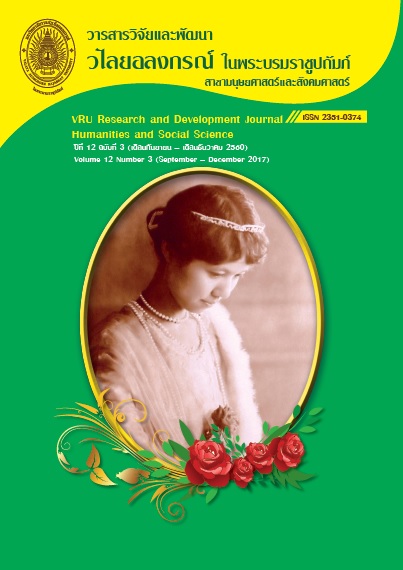รูปแบบการดูแลรักษาสุขภาพโดยใช้ภูมิปัญญาท้องถิ่นด้านการแพทย์พื้นบ้าน ในอำเภอท่าตะเกียบจังหวัดฉะเชิงเทรา
Main Article Content
Abstract
การวิจัยครั้งนี้ มีวัตถุประสงค์เพื่อ 1. ศึกษาสภาพการณ์การดูแลรักษาสุขภาพโดยใช้ภูมิปัญญาท้องถิ่นด้านการแพทย์พื้นบ้าน 2. ศึกษาองค์ความรู้ แบบแผนการปฏิบัติ และวิธีการดูแลรักษาสุขภาพของหมอพื้นบ้าน
และ 3. เสนอรูปแบบการดูแลรักษาสุขภาพโดยใช้ภูมิปัญญาท้องถิ่นด้านการแพทย์พื้นบ้านการวิจัยครั้งนี้ใช้วิธีการวิจัยเชิงคุณภาพ (Qualitative Research) การเก็บรวบรวมข้อมูลประกอบด้วยวิธีการเชิงคุณภาพ และวิธีการเชิงปริมาณ เก็บรวบรวมข้อมูลเชิงคุณภาพด้วยการวิเคราะห์เอกสาร การสังเกต การสนทนากลุ่ม และการสัมภาษณ์เชิงลึก จากผู้ให้ข้อมูลหลักซึ่งได้มาโดยการสุ่มตัวอย่างแบบเจาะจง จำนวน 22 คน ประกอบด้วยหมอพื้นบ้าน บุคลากรวิชาชีพด้านการแพทย์และสาธารณสุข และผู้บริหารองค์กรปกครองส่วนท้องถิ่น
การวิเคราะห์ข้อมูลเชิงคุณภาพใช้การวิเคราะห์เชิงเนื้อหา ส่วนข้อมูลเชิงปริมาณ เก็บรวบรวมข้อมูลด้วยแบบสอบถามจากกลุ่มตัวอย่างได้แก่ ประชาชนผู้มีประสบการณ์ด้านการแพทย์พื้นบ้าน จำนวน 400 คน กลุ่มตัวอย่างได้มาด้วยการสุ่มอย่างง่ายโดยใช้ตารางเครจซี่ และมอร์แกน สถิติที่ใช้ในการวิเคราะห์ข้อมูลเชิงปริมาณ ได้แก่ค่าความถี่ ค่าร้อยละ ค่าเฉลี่ย และส่วนเบี่ยงเบนมาตรฐาน
ผลการวิจัยพบว่า
1. สถานการณ์การดูแลรักษาสุขภาพโดยใช้ภูมิปัญญาท้องถิ่นด้านการแพทย์พื้นบ้าน พบว่า ภูมิปัญญาการแพทย์พื้นบ้านยังคงเป็นส่วนหนึ่งของวิถีชุมชนชนบท ชาวบ้านส่วนใหญ่รับการรักษากับหมอพื้นบ้าน และใช้วิธีการดูแลตัวเองร่วมด้วย
2. องค์ความรู้ในการรักษา พบว่า มาจากการสืบทอดมาตั้งแต่บรรพบุรุษ จากครูหมอพื้นบ้าน และการฝึกอบรมจากทางราชการ แบบแผนการปฏิบัติขึ้นอยู่กับแหล่งความรู้ หรือผู้ที่ได้ถ่ายทอดความรู้วิธีการรักษามีลักษณะผสมผสาน และใช้สมุนไพรในท้องถิ่นเป็นหลัก
3. รูปแบบการดูแลรักษาสุขภาพของหมอพื้นบ้านมี 5 ขั้นตอน ดังนี้ คือ 1) การซักประวัติผู้ป่วย 2) การตรวจสอบอาการ 3) การให้การรักษา 4) การให้คำแนะนำภายหลังการรักษา และ 5) การติดตามผลการรักษา การแพทย์พื้นบ้านจะมีส่วนช่วยในการดูแลรักษาสุขภาพของประชาชนอย่างเป็นรูปธรรม ต้องเกิดจากการส่งเสริมสนับสนุนของหน่วยงานที่เกี่ยวข้อง การสืบสานและการอนุรักษ์ของประชาชน แนวทางในการพัฒนาควรเป็นแนวทางอนุรักษ์ฟื้นฟูภูมิปัญญาการแพทย์พื้นบ้านตามบริบทที่เป็นจริง
The purposes of this qualitative research were to; 1) study the circumstances of healthcare using the local wisdom of indigeneous medicine 2) study the body of knowledge, patterns of practice, and methodologies of healers, and 3) present a model of healthcare using the local wisdom of indigeneous medicine. Data collecting involved a quantitative by a questionnaire and qualitative techniques. The qualitative data were collected by means of in-depth interviews, focus group discussions, observations, and analysis of documents. The sample obtained by purposive sampling consisted of 22 key informants, made up of: folk healers, health professionals, and executives of Local Administration Organizations. The collected qualitative data were analyzed by means of content analysis. On the other hand, the quantitative data were collected by a questionnaire distributed to respondents who were obtained by obtained by using a Crejcie & Morgan Calculation Table simple. The sample consisted of 400 people who had various experiences with indigeneous medicine. The statistics used for quantitative data analysis were frequency, percentage, mean, and standard deviation.
The results of the study were as follows:
- Pertaining to the circumstances of healthcare using the local wisdom of indigenous medicine, the study revealed that local wisdom of indigeneous medicine was still a part of these local communities’ way of life, i.e. villagers still received treatments from folk healers in combination with self-healthcare.
- Pertainnig to the body of knowledge, patterns of practices, and methodologies of folk healers, the study revealed that folk healers inherited knowledge from their predecessors, teachers of indigenous medicine, and from seminars/training courses organized by government officials. In terms of patterns of practice, these depended on learning resources or teachers/
trainers. In terms of methodologies of folk healers, they were assorted, mostly stressing on the use of local herbal medicines. - The model of healthcare used by folk healers was comprised of 5 stages, as follows: 1) collecting a patient’s medical information 2) diagnosis 3) treatment 4) giving instructions for post-treatment self-care, and 5) treatment follow up. Indigeneous medicine shall concretely contribute to villagers’ healthcare on the conditions that related government agencies strongly promote and support folk medicine concurrently with efforts by local people. The conservation of folk medicine should also be appropriately applied with in these local contexts.
Article Details
ลิขสิทธิ์บทความวิจัยที่ได้รับการตีพิมพ์เผยแพร่ในวารสารมนุษยศาสตร์และสังคมศาสตร์ วไลยอลงกรณ์ ในพระบรมราชูปถัมภ์ ถือเป็นกรรมสิทธิ์ของคณะมนุษยศาสตร์และสังคมศาสตร์ มหาวิทยาลัยราชภัฏวไลยอลงกรณ์ ในพระบรมราชูปถัมภ์ ห้ามนำข้อความทั้งหมดหรือบางส่วนไปพิมพ์ซ้ำ เว้นแต่จะได้รับอนุญาตจากมหาวิทยาลัยเป็นลายลักษณ์อักษร
ความรับผิดชอบ เนื้อหาต้นฉบับที่ปรากฏในวารสารมนุษยศาสตร์และสังคมศาสตร์ วไลยอลงกรณ์ ในพระบรมราชูปถัมภ์ เป็นความรับผิดชอบของผู้นิพนธ์บทความหรือผู้เขียนเอง ทั้งนี้ไม่รวมความผิดพลาดอันเกิดจากเทคนิคการพิมพ์


